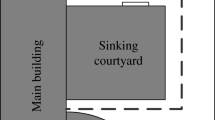Abstract
A design method of external elevation of high-rise Building based on emotional differential evolution algorithm in urban landscape design was proposed in this thesis to realize automatic generation of layout of high-rise building in urban landscape design. Firstly, brief description was conducted on automatic generation process of external elevation layout for high-rise building in differential evolution algorithm and urban landscape design and analysis was conducted on principle of differential evolution algorithm. Meanwhile, an improved algorithm of differential evolution based on social emotional operation was proposed to increase optimizing and rapid convergence ability of algorithm to realize optimization of design method of external elevation for high-rise building. Experimental result indicates that proposed algorithm has better optimization performance and experimental analysis was conducted on application of the algorithm in external elevation design of high-rise building.


Similar content being viewed by others
References
Kaboli, M.H.: Operational Research on An Urban Planning Tool: Application in the Urban Development of Strasbourg 1982 [D]. Université de Strasbourg, Strasbourg (2013)
Inert Cities: Globalization, Mobility and Suspension in Visual Culture [M]. IB Tauris (2014)
Galadari, A.I.: Evaluation of road construction alternatives: a regretful approach [M]. University of Colorado at Denver, Denver (2008)
Pan, W., Chen, S., Feng, Z.: Automatic clustering of social tag using community detection. Appl. Math. Inf. Sci. 7(2), 675–681 (2013)
Zhang, Y., Chan, J.W., Moretti, A., Uhrich, K.E.: Designing polymers with sugar-based advantages for bioactive delivery applications. J. Controll. Release 219, 355–368 (2015)
Zhang, Y., Li, Q., Welsh, W.J., Moghe, P.V., Uhrich, K.E.: Micellar and structural stability of nanoscale amphiphilic polymers: implications for anti-atherosclerotic bioactivity. Biomaterials 84, 230–240 (2016)
Chan, J.W., Zhang, Y., Uhrich, K.E.: Amphiphilic macromolecule self-assembled monolayers suppress smooth muscle cell proliferation. Bioconjug. Chem. 26(7), 1359–1369 (2015)
Abdelhamid, D.S., Zhang, Y., Lewis, D.R., Moghe, P.V., Welsh, W.J., Uhrich, K.E.: Tartaric acid-based amphiphilic macromolecules with ether linkages exhibit enhanced repression of oxidized low density lipoprotein uptake. Biomaterials 53, 32–39 (2015)
Orfall, B.: Bollywood retakes: literary adaptation and appropriation in contemporary Hindi cinema [M]. University of Oregon, Eugene (2009)
Author information
Authors and Affiliations
Corresponding author
Rights and permissions
About this article
Cite this article
Chunyu, D., Li, W. High building layout design based on emotional differential evolution algorithm. Cluster Comput 22 (Suppl 2), 5001–5007 (2019). https://doi.org/10.1007/s10586-018-2452-0
Received:
Revised:
Accepted:
Published:
Issue Date:
DOI: https://doi.org/10.1007/s10586-018-2452-0




